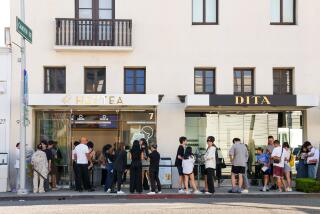Creating the Perfect Spotfor a Spot of Afternoon Tea
- Share via
BALTIMORE — There are few hours more agreeable than the hour dedicated to the ceremony known as afternoon tea.
-- Henry James
*
Seated at a table adorned with a fancy, flowered cloth and elegant white porcelain dishes, Margaret Sherer reaches with petite golden tongs for the two lumps of sugar that will sweeten her afternoon.
Today, Sherer, 57, has opted, as the English say, to take tea.
“I needed a peaceful place to be,” she says as she sips the aromatic sweet cherry tea she has chosen from a menu that includes Earl Grey, chai and a number of fruit teas.
Sherer is among the increasing number of people who have stopped at Gypsy’s Tea Room for an afternoon break.
Gypsy’s opened in June after owner Jo Fleck extended her gift-basket shop, Inspirations, to include Westminster’s first tearoom.
“It’s really created quite a stir; women are still really into teas these days,” Fleck says.
The idea for Gypsy’s arose after Fleck’s shop began holding monthly tea parties last year.
Fleck says people at the tea parties constantly asked when she would add a tearoom so they could take tea every week.
Gypsy’s preserves a long-standing tradition.
“Tearooms have been around forever,” says Joseph P. Simrany, president of the Tea Council of the United States of America. “Having tea at a tearoom was a very formal affair,” he says.
Afternoon tea--the name originally given to the English meal served midafternoon--traditionally includes finger sandwiches, scones, cakes and pastries accompanied by tea.
Women still revel in the elegance of the tradition.
“This is right up my alley,” says Carol Goettner, 55, a server at Gypsy’s. “I love everything about it.”
Tearooms are growing in popularity and are ever-evolving, Simrany says. He estimates that at least 1,000 tearooms operate in the United States, not including the high-priced teas at luxury hotels.
“Their names are even changing; they’re becoming tea bars, salons, houses, emporiums--you name it,” Simrany says. “Tearooms attracted mostly older women before. The new versions have all kinds of ages, and both sexes.”
Some of the growing appeal is the result of more varied menus. Many tea establishments serve not only traditional hot tea, but frozen teas, tea lattes and the increasingly popular bubble tea--a tea blended with the customer’s choice of ingredients and served in a tall glass with soft, chewy, gelatinous balls of tapioca in the bottom.
Although there are three basic teas--black tea, green tea and oolong tea--more than 3,000 varieties of tea are created by blending these teas with each other, or with various fruit.
The wide selection contributes to the popularity of tea, Simrany says.
“Tea was once considered an industry for mature women, but now so much information has come to our attention about tea--its varieties and its health benefits--that the concept of the tearoom runs the whole gamut, from bubble tea to afternoon tea.”
People who have sipped from Fleck’s ornate, dainty cups are more than satisfied.
“I think this place is fabulous,” Sherer says.
“My family has a tradition of giving healing tea; we learned it from my grandmother,” she says. “Some of my fondest memories are of having tea with my mother, and my oldest daughter has kept the tradition going with her daughter.”
Tammy Serafin of New Windsor and her 8-year-old daughter, Aubrey, have just begun a similar tradition.
The Serafins who attended Fleck’s mother-daughter tea last year--ordered Earl Grey and spring cherry tea.
“The [tearoom] is so pleasant and tranquil,” says Serafin, 36. “I’m going to come back again and again.”
*
Melody Holmes is reporter for the Baltimore Sun, a Tribune Co. newspaper.
More to Read
Eat your way across L.A.
Get our weekly Tasting Notes newsletter for reviews, news and more.
You may occasionally receive promotional content from the Los Angeles Times.








